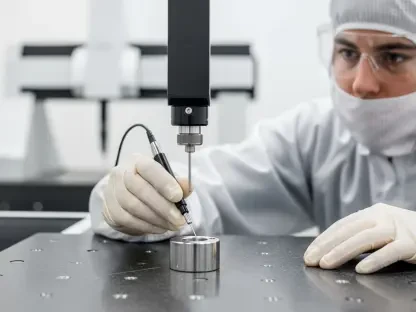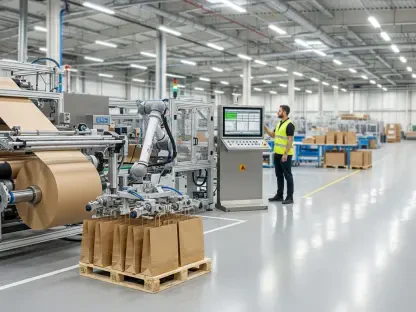The European Union has embarked on a transformative journey with its omnibus legislation, a sweeping initiative led by European Commission President Ursula von der Leyen, designed to overhaul the regulatory landscape for the manufacturing sector and reshape its future. This ambitious reform aims to simplify complex bureaucratic processes, reduce compliance burdens, and enhance industrial competitiveness across member states. By consolidating and revising a myriad of regulations, the legislation seeks to create a more business-friendly environment, enabling European manufacturers to rival their North American and Asian counterparts. With a focus on cutting red tape and speeding up approvals in key industries like transportation, artificial intelligence (AI), and chemicals, this policy shift promises to reshape how manufacturing operates. Yet, it also ignites a heated debate about balancing economic growth with sustainability and safety standards, raising questions about the long-term implications of such deregulation for the region’s industrial future.
Streamlining Regulations for Competitive Edge
The core intent behind the EU’s omnibus legislation is to dismantle excessive regulatory barriers that have long hindered manufacturing efficiency. By streamlining processes, the initiative aims to accelerate product approvals and market entry, particularly for innovative technologies in sectors such as AI and transportation. This deregulation is seen as a vital step to bolster the global standing of European manufacturers, who have often struggled under the weight of intricate compliance requirements. The European Commission argues that simplifying these frameworks will not only save time but also reduce operational costs, potentially leading to increased investments in research and development. For industries reliant on rapid innovation cycles, this could mean a significant advantage, allowing companies to bring cutting-edge solutions to market faster than ever before. However, the promise of efficiency must be weighed against the risk of oversight, as rushed approvals could compromise quality and safety in the pursuit of speed.
Beyond the immediate benefits of reduced bureaucracy, the legislation is poised to redefine how manufacturers allocate resources and plan for growth. Financial savings from fewer compliance checks could be redirected toward expanding production capacity or adopting advanced technologies, fostering a more dynamic industrial ecosystem. For instance, sectors like chemicals and transportation might see a surge in productivity as firms gain flexibility to experiment with new materials or logistics solutions without the fear of prolonged regulatory delays. Yet, this newfound freedom comes with caveats, as some stakeholders worry that the push for competitiveness might overshadow critical checks and balances. The challenge lies in ensuring that the drive for economic revitalization does not erode the foundational principles of accountability that have historically defined European manufacturing standards. Striking this balance will be crucial for the legislation to deliver sustainable progress across diverse industries.
Sector-Specific Impacts and Opportunities
The omnibus legislation’s influence varies widely across manufacturing sectors, presenting a mixed bag of opportunities and hurdles. In defense manufacturing, a proposed ‘defense readiness omnibus’ seeks to ease access to grants and simplify military transportation logistics, potentially strengthening the sector’s operational capabilities. Agricultural manufacturing stands to gain from estimated annual savings of €1.6 billion due to reduced environmental paperwork and compliance checks, which could enhance profitability for producers. Meanwhile, the chemical industry faces relaxed restrictions on certain substances, a move that might streamline production but raises concerns about health warnings on packaging. Each of these changes reflects a tailored approach to deregulation, aiming to address unique sectoral challenges while fostering growth. However, the diverse impacts also highlight the complexity of implementing a one-size-fits-all legislative framework.
In other areas, such as AI and cybersecurity manufacturing, the reduction in reporting requirements is designed to spur innovation by lowering administrative burdens. This could accelerate the development of cutting-edge technologies, positioning Europe as a leader in digital transformation. Financial manufacturing, on the other hand, may benefit from revised securitization rules that enhance lending capabilities and improve liquidity flow, supporting broader economic stability. Despite these potential upsides, apprehensions linger about the implications of reduced oversight, especially in high-stakes fields like technology and health-related products. Critics argue that while short-term gains are evident, the long-term effects on safety and reliability remain uncertain. As these sectors adapt to the new regulatory landscape, close monitoring will be essential to ensure that innovation does not come at the expense of consumer trust or systemic security.
Debating the Trade-Offs of Deregulation
One of the most contentious aspects of the omnibus legislation is its approach to environmental, social, and governance (ESG) standards, which many fear could be undermined by the focus on speed and efficiency. Critics, including European Parliament member René Repasi, caution that prioritizing rapid operations over thorough evaluations may lead to significant oversights, particularly in environmental accountability. There are estimates suggesting that up to 80% of manufacturing entities might be exempt from stringent environmental regulations under the new framework, a shift that could jeopardize progress toward net-zero goals. This potential rollback has sparked alarm among sustainability advocates, who argue that easing such standards risks damaging Europe’s reputation as a leader in ecological responsibility. The debate underscores a broader tension between immediate economic benefits and the imperative to safeguard long-term planetary health.
Adding to the complexity, the legislation’s relaxation of standards has divided industry players, with some embracing the reduced burden while others express concern over diminished ESG commitments. Manufacturers prioritizing sustainability worry that weaker regulations could disrupt supply chain integrity and erode consumer confidence in European products. Proponents, however, counter that excessive regulation has historically stifled competitiveness, and a more agile framework is necessary to keep pace with global markets. This divergence of perspectives highlights the challenge of aligning short-term economic imperatives with enduring ethical responsibilities. As the legislation moves forward, finding a middle ground that supports industrial agility without compromising core values will be paramount. The outcome of this debate could set a precedent for how Europe navigates similar regulatory dilemmas in the years ahead.
Reflecting on a Balanced Path Forward
Looking back, the EU’s omnibus legislation emerged as a bold attempt to revitalize manufacturing by slashing bureaucratic constraints and fostering a competitive edge. Its implementation revealed both the promise of streamlined operations and the pitfalls of reduced oversight, igniting a nuanced dialogue about the future of industrial policy. The diverse impacts across sectors like defense, agriculture, and AI underscored the complexity of applying broad reforms to varied industries. Meanwhile, the contentious rollback of ESG standards served as a stark reminder of the delicate balance between economic growth and sustainability. As the dust settled, it became evident that while efficiency gains were achieved, the cost to environmental and safety benchmarks prompted significant reflection. Moving forward, policymakers and industry leaders must prioritize mechanisms to monitor and adjust these reforms, ensuring that innovation thrives without sacrificing accountability. Collaborative efforts to refine this framework could pave the way for a manufacturing landscape that harmonizes progress with responsibility.









